By Carlo Platella
Mercedes turns the page, presenting a car that is visually impactful and profoundly different from the previous one. The new concept, long announced by the leaders of Brackley, does not lie so much in the forms, but in the basic concept of the car. The difficulties faced in the last two years have pushed the team on a long path of analysis, developing a better general understanding not only of their cars, but of the physics of ground effect. The greater awareness led the team to review the project priorities, re-evaluating the desired behavior on the track. The new objectives led to a review of the simulation models and in general the entire decision-making process, generating as a final result a car with revolutionized shapes, such as the W15.
Compromise choices
The ground clearance is one of the main parameters to change on the W15. By their nature, ground effect Formula 1 cars release more aerodynamic load the closer they travel to the ground, but not without some side effects. In this sense, Mercedes had exaggerated with the low W13 of 2022, afflicted by chronic porpoising, only to then sin with the opposite defect in 2023, with a car that was too high and therefore lacking in load.
The W15 will return to get closer to the ground thanks to the support of the new suspensions, designed to better stabilize the surface at constant heights from the ground and “postures”. However, technical director James Allison has repeatedly reiterated the importance of not exaggerating with proximity to the ground, for a twofold reason. The high load generated would bring with it an excess of resistance in a straight line, to which would be added the extreme stiffness of the suspension, necessary to stabilize the surface but detrimental to agility in slow curves. The 2024 Mercedes is therefore born lower compared to its progenitor, but the new concept does not aspire to descend to record heights from the ground, preferring a compromise solution.
They then went to Brackley reevaluate other priorities, such as aerodynamic robustness in the wind or the importance of transients, taking care not only of the different postures of the car while driving, but also of the movements of transition from one to the other. Mercedes has corrected its virtual simulation CFD models to highlight specific aerodynamic behaviors, for example by modifying the mesh generation techniques. The result is a car profoundly different from the previous one, in terms of shape but above all in its basic concept. “We hope that some of the more grumpy rear-end behavior of the car is a little tamer and that the car's handling has improved.”the hope of James Allison.
Chassis
The W15 completes the change in concept undertaken last season, a process however limited by pre-existing constraints. For this reason, the 2024 Mercedes was created around a new chassis, of which some differences can be appreciated from the outside, including the repositioning of the side impact protection cones. In Brackley, attempts were also made to meet the requests made by Lewis Hamilton, including a more rearward driving position for a better perception of the car's behavior. Lateral comparisons always risk being misleading, but the first impression is that on the W15 there has been an actual setback of the passenger compartment by a few centimeters (1).
It is also new the front impact structure, technical term to identify the nose. In detail, the lower part of the muzzle appears more hollowed out and rounded compared to the 2023 specification (2). The objective is to develop better local control of the flows towards the bottom, as well as manage the turbulence coming from the front.
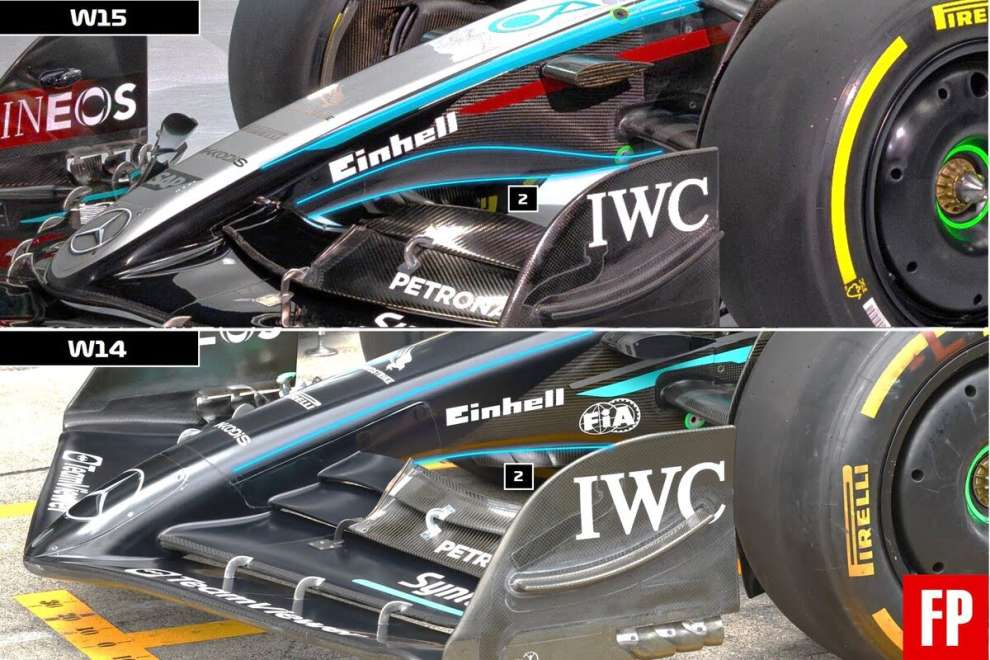
Suspensions
The suspension units constitute a crucial area for the W15, allowing for better control of the aerodynamic platform, an area in which the team has sinned in recent seasons. At the front Mercedes continues with the push-rod schemedifferentiating itself in this aspect from rivals Red Bull and McLaren, also keeping the steering arm aligned with the lower triangle.
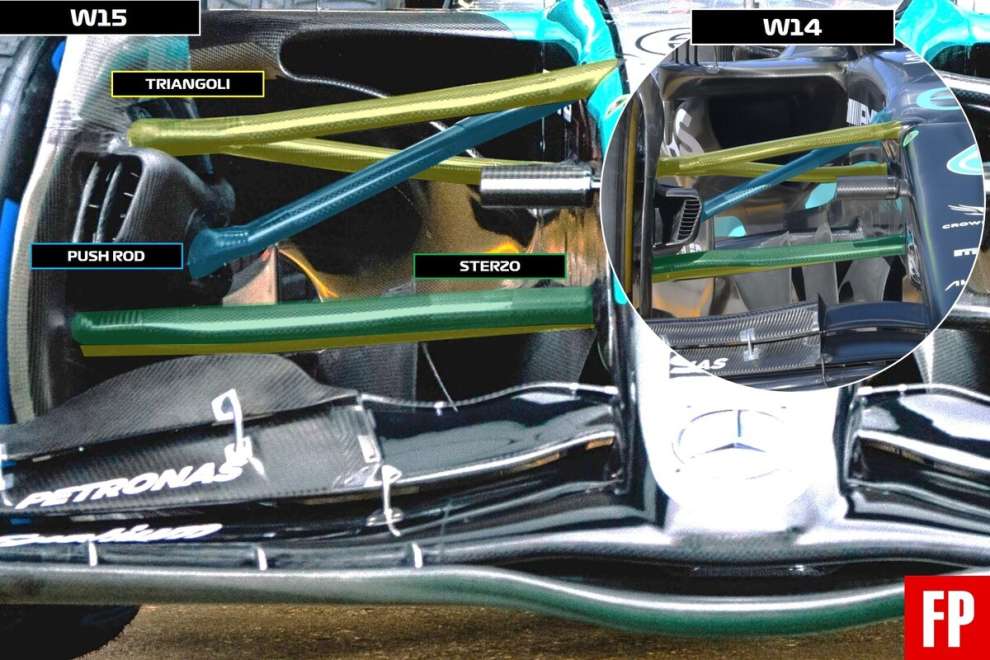
As is now customary in the era of ground-effect Formula 1, the upper triangle accentuates the anti-pitching kinematics, however already fairly marked in 2023 (3). The front and rear arms are staggered in height to stabilize the rotations of the floor during braking and traction, as well as to correctly guide the flows towards the entrance of the Venturi channels.
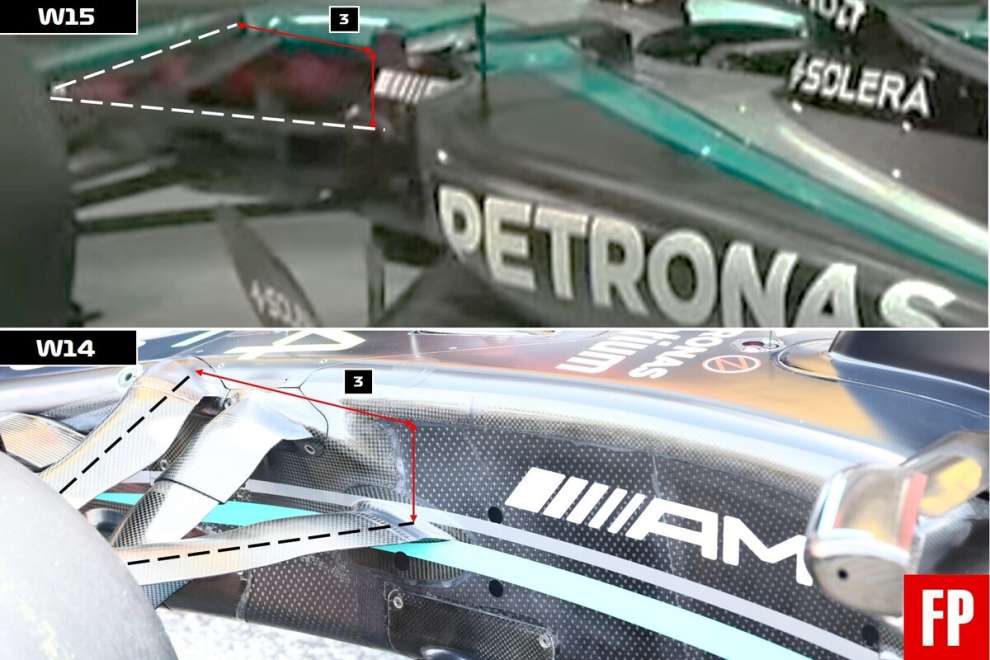
The great revolution is instead concentrated in the rear suspension, shared with Aston Martin and Williams. The conversion to the flat-bottomed bodywork led to a review of the arrangement of the external elements, with the aim of freeing up space in the lower part to facilitate the passage of the flows collected by the sides. The suspension thus abandons the pull-rod scheme, switching to a strut kinematic mechanismredesigning the transmission box to house the spring-shock absorber unit in a raised position.
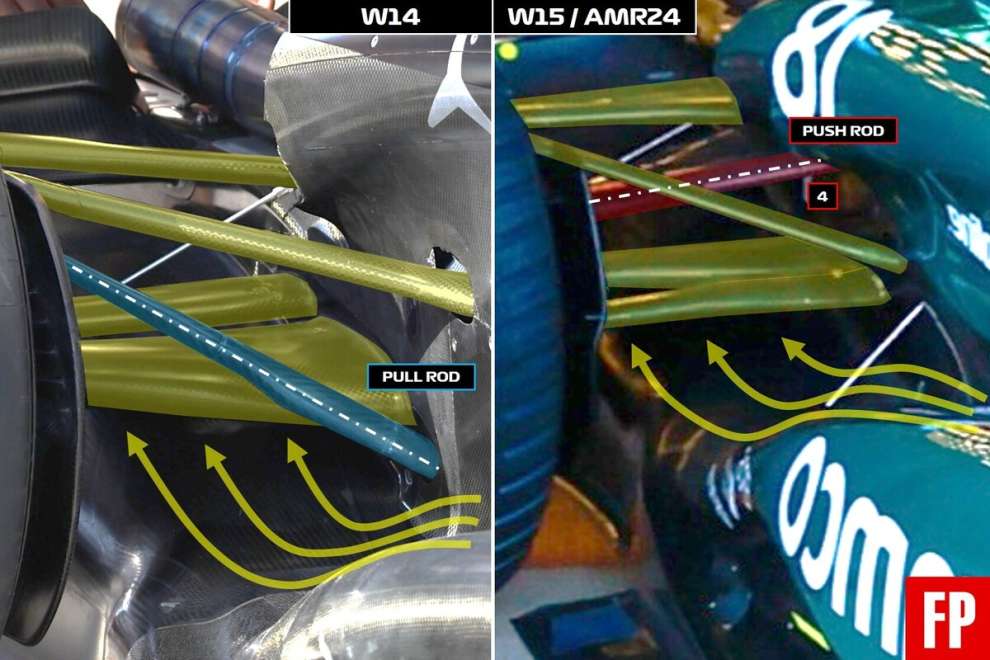
It wouldn't be an understatement to describe the W15's rear suspension as extreme. The strut is strongly reclining, with an almost horizontal inclination (4), in contrast to the rod used for example by Red Bull. The impression is that Mercedes has undertaken a mechanically bold and compromise project, which however is rewarded on paper by better overall aerodynamic performance.

Aileron
The front wing is another component of great interest on the W15, with many new features compared to last season and some solutions resulting from the exploitation of the grid areas of the regulation. The nose now stops on the penultimate element (5), freeing the opening with the main profile to blow air under the car. The shape of the upper flaps (6) is also totally different, reviewing both the flow distribution between the external and internal parts of the wheels and the generation of the vortices. There is also a slight widening of the fixed section of the profiles (7), unlike the competition which tends to widen the adjustable portion.
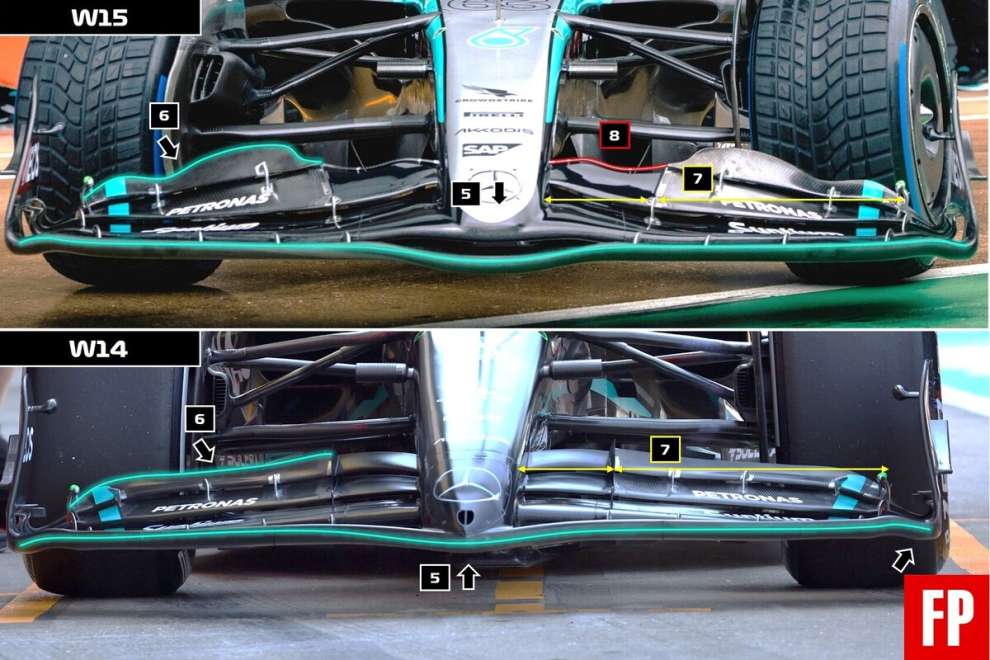
The main inspiration is offered by the fixed section of the last flap (8). Mercedes has effectively removed this element, leaving just a thin line of carbon to comply with the technical regulation, which requires the continuity of the wing up to the nose. The wing of the W15 recalls those of the previous generation of cars, where the flaps ended abruptly on the inside. The exposed tips generated what is known as the Y250 vortex, terribly valuable for counteracting external wheel turbulence and energizing bottomward flow. The geometry proposed by Mercedes in 2024 was certainly not in the intentions of the legislators, but the experts are divided on whether the solution should be considered compliant with the regulation or not.
Air vents
Mercedes doesn't just emulate what its rivals have done and the radiator vents are another demonstration of this. The side vents do not follow the general trend, which sees teams squashing and enlarging their vents. At Brackley an irregular geometry was preferred (9), which lengthens near the frame to benefit from cleaner flows.
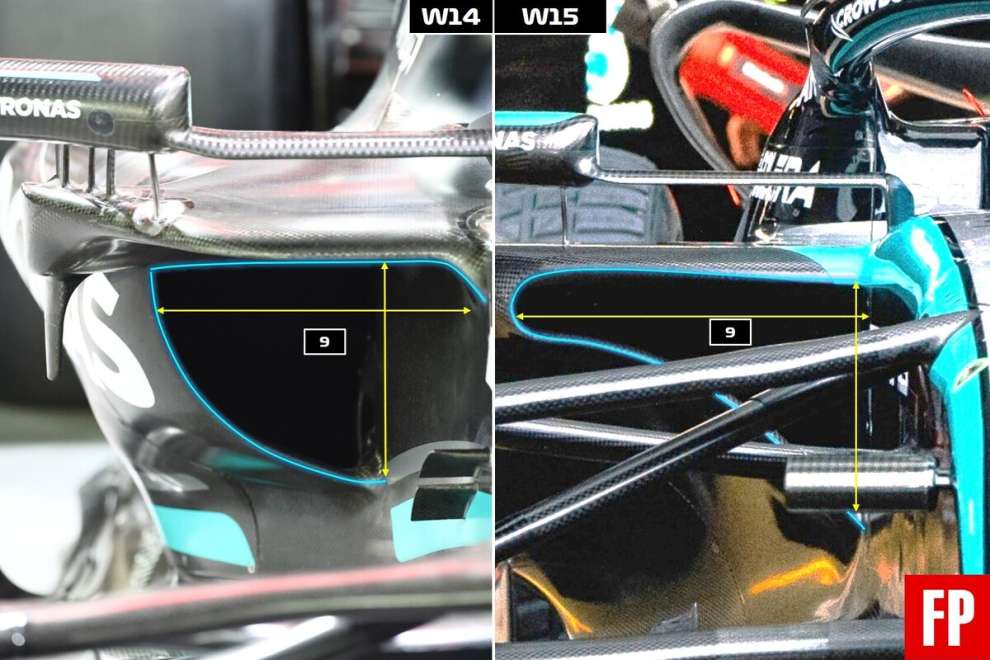
From the side you can appreciate how the upper protection cone is no longer separated from the belly, but is now integrated into the air intake (10). The previous central wing disappears, which also acted as a vortex generator. Finally, the radiator mouths do not have one lip further forward than the other, as seen on many rival cars.

Car body
The complete W15 the work of conversion to beaten bellies undertaken in 2023, definitively abandoning the narrow-sided or zeropods geometry. Great work was done to reposition the components under the skin, radiators and electronics above all, now suspending the belly above the bottom to facilitate the transport of flows and energy towards the speaker.
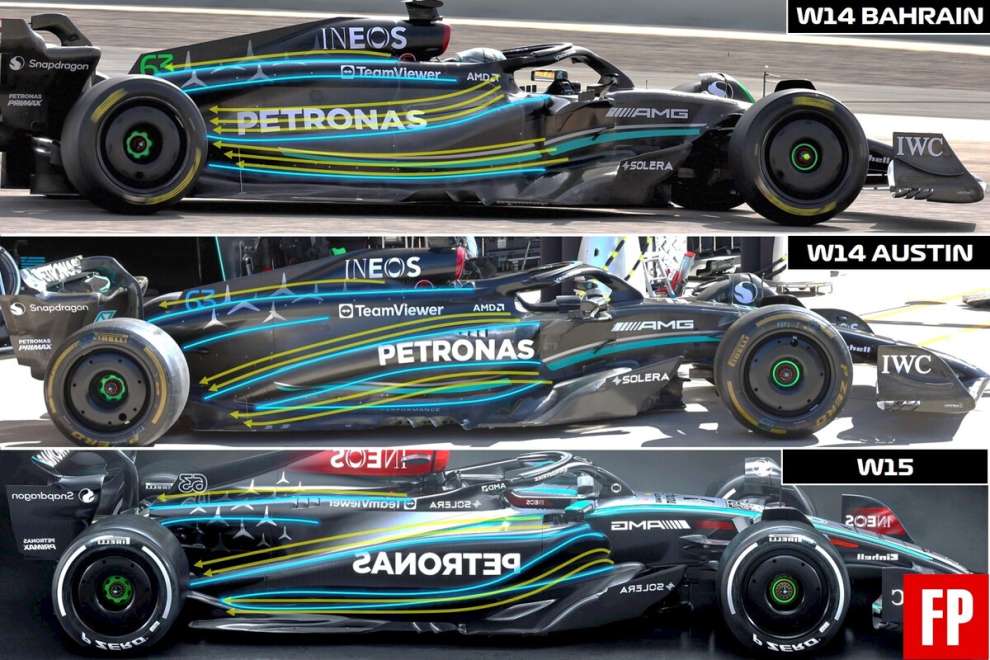
One of the areas where Mercedes had set the example in 2023 it was in the shape of the upper part of the bonnet, wide and flattened to separate the hot air of the engine compartment from the aerodynamic flows in the lower part. The W15 abandons this approach, preferring a narrower vent (11) inspired by Red Bull, which, according to the few filtered images of the RB20, would instead seem to refer to the Mercedes geometries of 2023.

Bottom
The shakedown of the W15 offers the rare opportunity to preview some details of the work carried out on the fund. You can see it from the front a complete overhaul of the flow conveyor grid at the entrance to the Venturi channels (12). What changes above all is the width distribution of the various sections, suggesting a different sorting between the more internal flows, conveyed up to the diffuser, and the external ones expelled laterally.

Under the side, the different fairing of the lower anti-intrusion cone (13) stands out, used to better structure the flows along the outer edge of the bottom. This very area (14) is a direct evolution of the late 2023 specification, developed with the updates introduced in Austin.
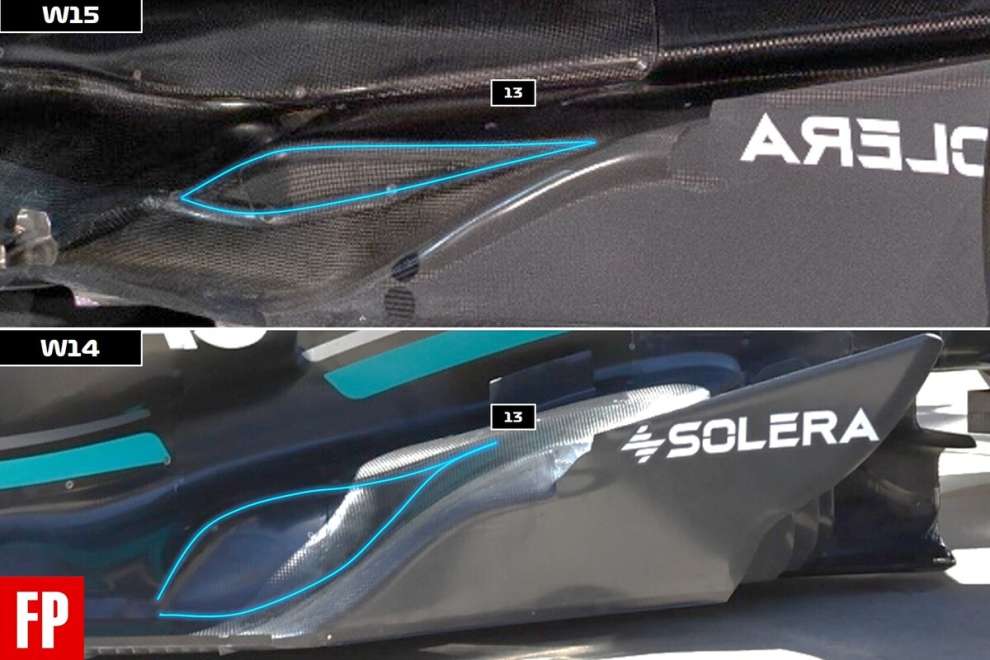
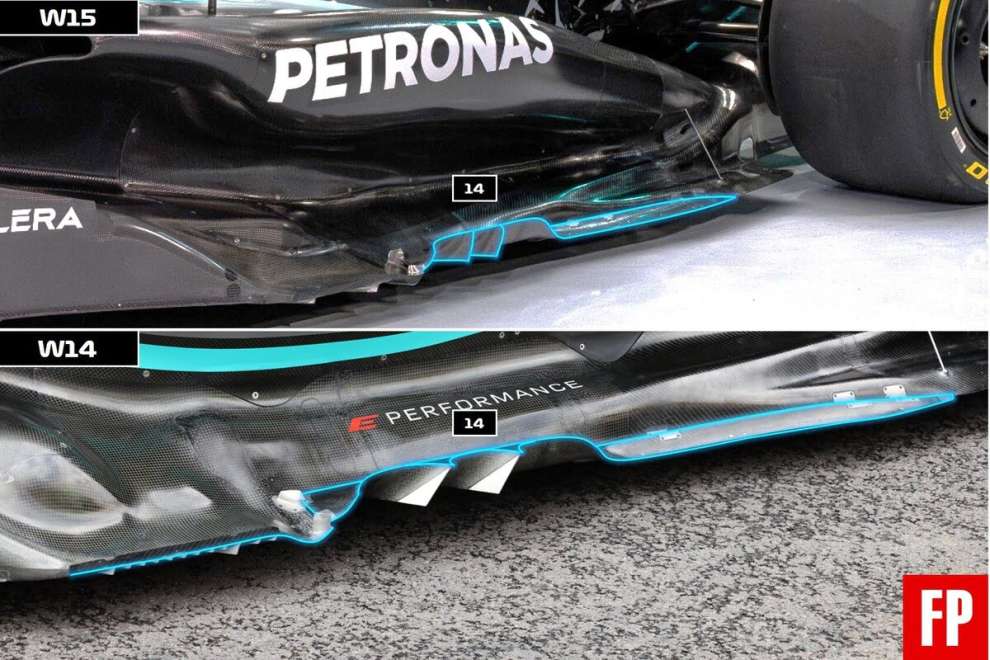
Doubts to be swept away
Overall, Mercedes aims to improve the main shortcomings for 2023, especially rear instability, but not only that. “We worked hard for create a car with less aerodynamic drag”, announces technical director James Allison. The W15 is a car full of innovative and interesting solutions, but what will be judged above all will be the objectives that guided the new shapes.
“It's about asking what we did wrong and why the virtual simulations didn't correlate to the real world”Toto Wolff's commentary on the analyzes conducted in recent years. “I think we found some tracks. We tried to eliminate as many variables as possible.” The image of a team that tries to exclude variables to trace the origin of the problems does not show particular certainty on the path to follow, suggesting a still uncertain approach. The tests in Bahrain will tell if Mercedes has not yet found all the answers to its questions or if instead Toto Wolff has preferred to express himself with caution, mindful of the disappointments of recent seasons.
#Mercedes #technical #analysis #concept #W15